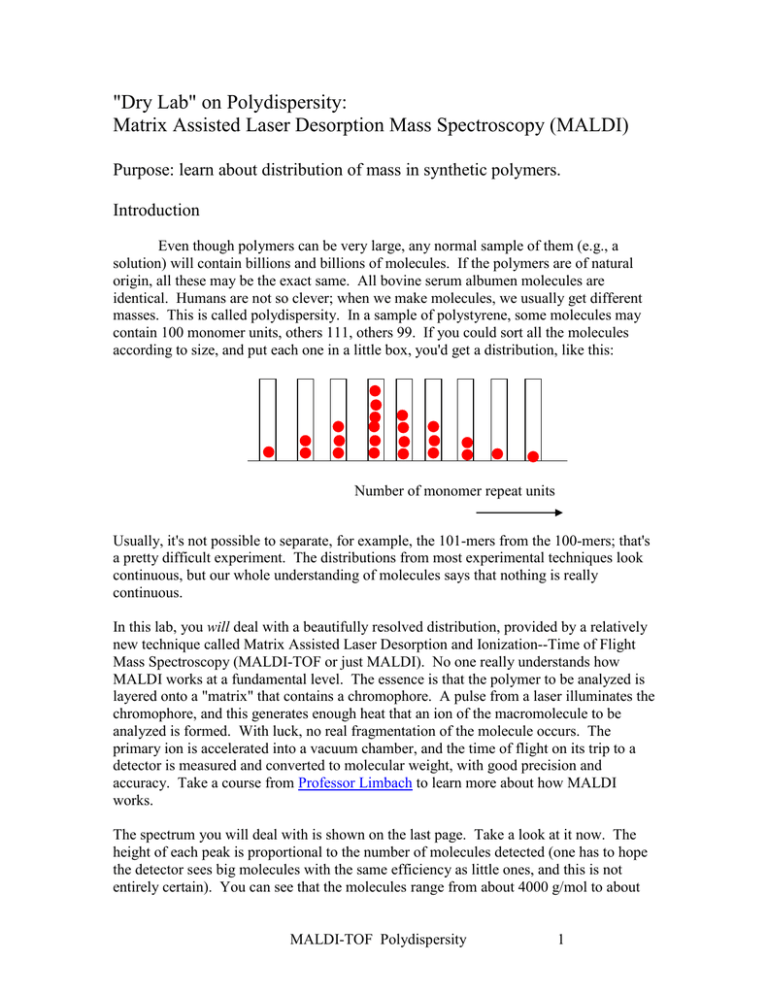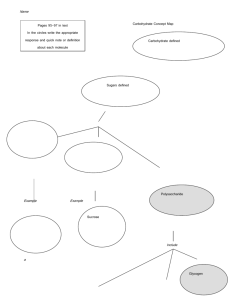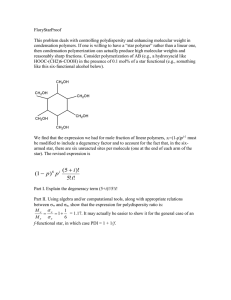Polydispersity (MALDI-TOF dry lab )
advertisement

"Dry Lab" on Polydispersity: Matrix Assisted Laser Desorption Mass Spectroscopy (MALDI) Purpose: learn about distribution of mass in synthetic polymers. Introduction Even though polymers can be very large, any normal sample of them (e.g., a solution) will contain billions and billions of molecules. If the polymers are of natural origin, all these may be the exact same. All bovine serum albumen molecules are identical. Humans are not so clever; when we make molecules, we usually get different masses. This is called polydispersity. In a sample of polystyrene, some molecules may contain 100 monomer units, others 111, others 99. If you could sort all the molecules according to size, and put each one in a little box, you'd get a distribution, like this: Number of monomer repeat units Usually, it's not possible to separate, for example, the 101-mers from the 100-mers; that's a pretty difficult experiment. The distributions from most experimental techniques look continuous, but our whole understanding of molecules says that nothing is really continuous. In this lab, you will deal with a beautifully resolved distribution, provided by a relatively new technique called Matrix Assisted Laser Desorption and Ionization--Time of Flight Mass Spectroscopy (MALDI-TOF or just MALDI). No one really understands how MALDI works at a fundamental level. The essence is that the polymer to be analyzed is layered onto a "matrix" that contains a chromophore. A pulse from a laser illuminates the chromophore, and this generates enough heat that an ion of the macromolecule to be analyzed is formed. With luck, no real fragmentation of the molecule occurs. The primary ion is accelerated into a vacuum chamber, and the time of flight on its trip to a detector is measured and converted to molecular weight, with good precision and accuracy. Take a course from Professor Limbach to learn more about how MALDI works. The spectrum you will deal with is shown on the last page. Take a look at it now. The height of each peak is proportional to the number of molecules detected (one has to hope the detector sees big molecules with the same efficiency as little ones, and this is not entirely certain). You can see that the molecules range from about 4000 g/mol to about MALDI-TOF Polydispersity 1 7000 g/mol. So this is a small polymer. (MALDI still doesn't work that well for big ones, but it's getting better). In this course, we are going to learn several other ways to measure molecular weight and its distribution. These methods do not have the exquisite resolution of MALDI, but they operate over a much wider range of molecular mass, and they can provide other information that MALDI cannot (e.g., aggregation, size, shape). Some of the methods can produce only an average molecular weight, with no information at all about the distribution. To make matters worse, not all the methods produce the same average. Averages for Polymers Number Average. If you just took the total weight of polymers and divided by the total number of polymers, that would be the number average. A formula for doing this is: Mn n M i 1 i i n i i 1 Here, ni is the number of molecules in the sample having i monomers (e.g., if i = 2 we are talking about dimers). Mi is the molecular weight of an i-mer: MI=iMo Where Mo is the monomer mass. Exercise: compute the number average molecular weight of our class. Everyone will write their weight on a blank piece of paper. We'll tally the sum, divide by the number enrolled, and that's Mn for our class. Experiments that respond according to number average End group analysis (all polymers have one end) Colligative (osmometry, boiling point elevation, freezing point depression) Weight Average. If you wanted to assign greater importance to heavier molecules (some experiments do this--can you guess which ones?) you would compute Mw n M i 1 i 2 i n M i 1 i i Squaring the M immediately assigns greater importance to higher masses. You have to put an M in the denominator to make the units come out right. Another MALDI-TOF Polydispersity 2 way to look at this is to recognize that niMi is the total mass of i-mers. Let gi = total mass of i-mers: gi = niMi Therefore, we see that Mw is a molecular weight counted according to mass or (let's not quibble) weight. This explains the name. Mw g M i i 1 g i 1 i i Experiments that respond according to weight average Sedimentation (the bigger they are, the harder they fall) Light Scattering (this isn't obvious) Z Average. If you really wanted to assign importance to heavy molecules you would compute: Mz n M i n M 2 i i 1 i 1 i i 3 There actually are a few quantities in polymer science that relate to the z average (peculiarities like the square of the size in a static light scattering experiment). What's normal? Our experience with measurements of various phenomena in this universe teaches us that "normal" is the same as "most probable". And the "most probable" distribution of sizes is what usually happens in synthetic chemistry. This "most probable" distribution is characterized by certain "polydispersity ratios" or "polydispersity indexes": Mz Mw 2 and 3 Mn Mn What's exceptional? Mw 1 You might say that Mn nature is "singularly" exceptional. (Go back to the formulae above and see that Mn = Mw = Mz when there is only one term in the sum.) Well, nature is. For a pure protein, or for DNA: MALDI-TOF Polydispersity 3 Mw 1.02 One Mn outcome of this "experiment" is that you will see how good our best really is. Like any other worthwhile pursuit, macromolecular science provides metaphors for life in general, not to mention ample opportunities to develop a philosophical outlook. The best preparations by humans might be something like Assignment 1. Compute Mn, Mw and Mz for the distribution provided. How you do it is up to you; I recommend a ruler and a spreadsheet or general purpose computer program. 2. Report all the polydispersity ratios and comment on the polydispersity of this polymer compared to "perfect". 3. Identify what kind of polymer this is. I leave it to you to figure out how to do that. (Hint: it is a common polymer, well prepared). MALDI-TOF Polydispersity 4

